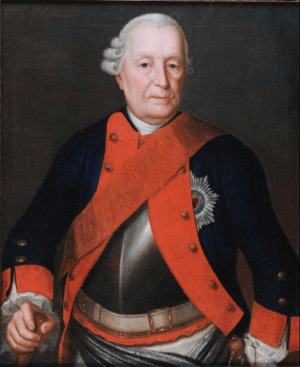Hans von Lehwaldt facts for kids
Quick facts for kids
Hans von Lewhwaldt
|
|
|---|---|
 |
|
| Born | 24 June 1685 Labiau, Prussia |
| Died | 16 November 1768 Berlin |
| Buried |
Juditten Church
(54°42′57″N 20°25′29″E / 54.71583°N 20.42472°E) |
| Allegiance | |
| Service/ |
Army |
| Years of service | 1700–1765 |
| Rank | Generalfeldmarschall |
| Battles/wars | |
| Awards | Pour le Mérite (1742) Black Eagle Order (1744) Equestrian statue of Frederick the Great 1851 |
Hans von Lehwaldt (born June 24, 1685 – died November 16, 1768) was an important military leader from Prussia. He was a Generalfeldmarschall, which is a very high rank in the army. He joined the military in 1700 and fought in many major wars. These included the War of the Spanish Succession and the Seven Years' War. He was especially known for his bravery and skill during the wars in Silesia and the Seven Years' War, serving under Frederick the Great.
Contents
Early Life
Hans von Lehwaldt was born in a place called Legitten. This town was near Labiau in the Duchy of Prussia. His mother, Marie Esther, came from an old and respected family.
Military Beginnings
Lehwaldt started his military career in 1699. He joined a special army unit called the "Weiße Grenadier-Garde." His first real battle experience was in 1702. This was during the War of the Spanish Succession, when he took part in the siege of Venlo.
In the spring of 1704, his unit fought in the famous Battle of Blenheim. This was a major battle in European history. After this, Lehwaldt was promoted to Fähnrich on September 16. He also helped in the siege of Hagenau later that year. In 1715, he fought against Sweden in Pomerania during the Great Northern War.
Wars of Austrian Succession
First Silesian War
When Prussia started its war with Austria, Lehwaldt was with Prince Leopold von Anhalt's army. In 1742, he marched with Prince Leopold and King Frederick II of Prussia to Silesia. There, he fought in the Battle of Chotusitz on May 17. Prussia won this battle, which led to the Treaty of Breslau. This treaty gave Prussia control of Silesia.
Second Silesian War
In the Second Silesian War, Lehwaldt first served with General Johann Friedrich Adolf von der Marwitz. Later, he led his own special group of soldiers. On February 14, 1745, he commanded his troops against the Austrians at Halberschwerdt. His actions in this battle greatly impressed King Frederick.
King Frederick rewarded Lehwaldt for his service. He received the Pour le Mérite medal in 1742. This was after the First Silesian War. He also received the Order of the Black Eagle on February 4, 1744. This was another very important award.
On January 22, 1751, Lehwaldt was promoted to Generalfeldmarschall. This was the highest rank a general could achieve. King Frederick also gave him a special medallion with his own portrait on it. Only two other generals, Wilhelm Dietrich von Buddenbrock and Friedrich Wilhelm von Dossow, received this rare honor.
Seven Years' War
Defending East Prussia
In 1756, tensions grew between European powers. King Frederick sent Lehwaldt to lead the forces in East Prussia. He gave Lehwaldt the power to choose new officers to strengthen the army there.
The Russian army, led by Field Marshal Stepan Fyodorovich Apraksin, invaded East Prussia. They had about 55,000 soldiers. In 1756, they captured Memel, which became their base. Apraksin tried to surround the Prussian army. However, Lehwaldt, with only 25,000 troops, managed to avoid being trapped.
Battle of Gross Jägersdorf
Instead of being surrounded, Lehwaldt's army met a part of the Russian army. This happened at the Battle of Gross Jägersdorf. The Russian commander, Vasily Loupukhin, was killed in the fighting. The rest of Apraksin's army then joined the battle. Lehwaldt's army suffered about 4,600 casualties. The Russians had about 7,000 casualties.
Even though Lehwaldt's forces had to pull back, the Russians could not continue their attack. Apraksin's troops were running low on supplies. They also heard a false rumor that Empress Elizabeth of Russia had died. Because of this, Apraksin decided to retreat from the province.
Later Service
After the battle, Lehwaldt oversaw the Blockade of Stralsund. This kept Swedish forces from moving freely on the Baltic Sea.
Due to his poor health, Lehwaldt was moved to Berlin in 1759. He became the governor of the city. In October 1760, Berlin and Potsdam were captured and looted. This was done by Austrian and Russian forces. Lehwaldt and another general, Friedrich Wilhelm von Seydlitz, were both unwell. They could not stop the attack on the mostly unprotected cities.
Hans von Lehwaldt died in Königsberg in 1768. He was buried in the Juditten Church.
See also
 In Spanish: Hans von Lehwaldt para niños
In Spanish: Hans von Lehwaldt para niños

